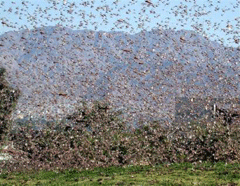Note on Emerging Science
Air Date: Week of May 8, 2009
 |
What’s the difference between a harmless grasshopper and the Biblically notorious locust? Apparently, just a dose of serotonin. Lindsay Breslau reports on the Dr. Jekyll and Mr. Hyde of the insect world.
Transcript
YOUNG: It’s Living on Earth. I’m Jeff Young.
CURWOOD: And I’m Steve Curwood.
Coming up – a new tool to help you shop greener – but first, this note on emerging science from Lindsay Breslau.
[LOCUSTS BUZZING]
BRESLAU: A small, green grasshopper sits alone on a blade of grass, innocently munching on the juicy stalk. It seems harmless, but beware. One day it may join a gang.
[EMERGING SCIENCE THEME]
In 1921, scientists discovered that the green desert grasshopper is the same species as the destructive, yellow and black locust. But the split personality of the creature remained a mystery.
Recently, a group of researchers from Britain and Australia linked this behavior transformation to serotonin, a brain chemical found in all complex organisms. They discovered that the nervous systems of swarming locusts contain three times as much serotonin as solitary locusts.

A swarm of locusts.
By tickling a grasshopper's hind legs to simulate jostling by other locusts, the scientists could transform the solitary insect into a social creature within hours. To test their theory, they injected a serotonin inhibitor before tickling the legs and found no behavior change. But when the researchers injected a serotonin promoter and didn't stroke the insects, they changed color, grew large muscles, and behaved gregariously.
During droughts, locusts are forced into small areas to look for food. Close contact with other locusts causes this chemical change, creating swarms that can number in the billions.
Scientists hope that this discovery about serotonin will lead to research on how they could rehabilitate the violent gangs of locusts and turn them back into harmless grasshoppers.
That's this week's note on emerging science. I'm Lindsay Breslau.
Living on Earth wants to hear from you!
Living on Earth
62 Calef Highway, Suite 212
Lee, NH 03861
Telephone: 617-287-4121
E-mail: comments@loe.org
Newsletter [Click here]
Donate to Living on Earth!
Living on Earth is an independent media program and relies entirely on contributions from listeners and institutions supporting public service. Please donate now to preserve an independent environmental voice.
NewsletterLiving on Earth offers a weekly delivery of the show's rundown to your mailbox. Sign up for our newsletter today!
 Sailors For The Sea: Be the change you want to sea.
Sailors For The Sea: Be the change you want to sea.
 The Grantham Foundation for the Protection of the Environment: Committed to protecting and improving the health of the global environment.
The Grantham Foundation for the Protection of the Environment: Committed to protecting and improving the health of the global environment.
 Contribute to Living on Earth and receive, as our gift to you, an archival print of one of Mark Seth Lender's extraordinary wildlife photographs. Follow the link to see Mark's current collection of photographs.
Contribute to Living on Earth and receive, as our gift to you, an archival print of one of Mark Seth Lender's extraordinary wildlife photographs. Follow the link to see Mark's current collection of photographs.
 Buy a signed copy of Mark Seth Lender's book Smeagull the Seagull & support Living on Earth
Buy a signed copy of Mark Seth Lender's book Smeagull the Seagull & support Living on Earth

